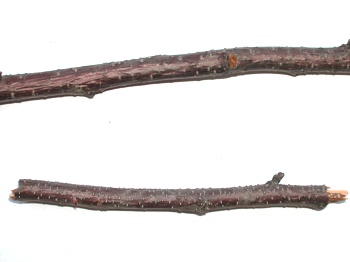Diseases
Cytospora leucostoma Fr. - Cytospora Twig Die Back
Systematic position.
Division Deuteromycota, class Coelomycetes, order Sphaeropsidales, family Sphaeropsidaceae, genus Cytospora.Biological group.
This species is a biotroph.Morphology and biology.
The parts of the plant that are mainly affected include the shoots, branches, stems; the roots and fruits are affected less often. Outer symptoms of the diseases include the death of bark cambium and wood of plants. The bark becomes red-brown or black-brown, and separated bark frays. Affected trees dry out; root neck remains viable, forming shoots. The tree dies off gradually; some shoots die off in the beginning, then one parent branch, and later the other ones die off. Finally, the tree perishes completely. Infection occurs in early spring or in autumn during a dormant period mainly. In summer, during vegetation, stone fruit crops are resistant to this disease, except strongly weakened trees. The affected trees dry out in the spring before buds blossom or during blossoming. The opened flowers roll, brown, and die, not dropping to the ground for a long time, remaining on dry branches. The leaves are smaller, slightly chlorotic (light yellow with yellowish shade). At the end of May or in June the affected leaves droop, not losing green color. The fungi over-winter as pycnidia (0.5-1.5 mm in diameter) on dried parts of plants. Under humid weather conditions the pycnidia produce threads of stuck spores within dead bark; the threads are orange-red, spirally rolled; the spores are colorless, unicellular, curved, 5-8 x 1-2 microns.Distribution.
High severity of the Cytospora Twig Die Back of pear (every 2nd year 50-100% trees are affected) is observed in areas of intensive fruit growing in the North Caucasus (in the northern part of the Krasnodar and Stavropol Territories, in the Rostov Region, the Black Sea region, Kabardino-Balkaria, Chechnya, Ingushetia, Alania), in the most humid areas of Transcaucasia, in Moldova, Ukraine (Crimea), East Georgia, Armenia. Moderate severity of the disease (every 3rd year 30-50% trees are affected) is observed in the southern part of the Krasnodar and Stavropol Territories, in Adygea, Karachay-Cherkessia, Lithuania, Kazakhstan, and republics of Central Asia. Low severity (every 5th year 10-30% trees are affected) of the disease is observed in fruit growing areas of the Far East, in the Moscow Region. General distribution of the disease includes Turkmenistan, Kara-Kalpakstan, Novosibirsk Region, Latvia, the Leningrad, Orel, Tambov, Kursk, Voronezh Regions.Ecology.
The disease develops when air humidity is 60 to 95% and temperatures range from 10 to 30 degrees C.Economic significance.
Affected leaves drop prematurely, and shoots shedding leaves have no time to prepare themselves for winter; yield quality and quantity decreases. Control measures include the use of plant cultivars that are less susceptible to the disease, realization of sanitary actions directed towards a decrease of the infection reserve, and also chemical treatments.Reference citations:
Bazerashvili L.G. 1985. Complexes of fungi concomitant to drying of peach and apricot, and ecological substantiation of control measures. Tbilisi: Goskomizdat Gruz. SSR. 24 p. (In Russian)Byzova, Z.M., Vasyagina, M.P., Deeva, N.G., Kalymbetov, B.K., Pisareva, N.F. & Shvartsman S.R. 1967. Flora of spore plants of Kazakhstan. V. 5, Part 1. Sphaeropsidales. Alma-Ata: Nauka. 339 p. (In Russian)
Cherepkova N.A. 1977. Affection of fruit crops by the drying in subtropics of Krasnodar Territory. Byulleten VIZR (Leningrad), 40: 48-51. (In Russian)
Dobrovolskene A. 1969. Biological researches of drying (agent Cytospora capitata Sacc. et Schulz.) of fruiters in Lithuanian SSR. In: Midvikiene D., ed. Intensification of agriculture production. Proceedings. Vilnus: Mintis. V. 16, Issue 2(41): 48. (In Russian)
Gerbanevskaya E.V. 1958. Nature drying of stone fruit crops. In: Solobyeva A.I., ed. Collection of scientific phytopathologic works of VIZR Central Asian branch. Tashkent: VIZR. 23-30 p. (In Russian)
Isin M.M. 1981. Specialization of some Cytospora species on fruit-berry species, trees and shrubs. In: Emelyanov V., ed. Plant protection against pests and diseases. Elgava: Lithuanian Agricultural Academy. 76-78 p. (In Russian)
James P.W., Hawksworth D.L. 1971. Ainsworth & Bisby.s dictionary of the fungi. 6th edition. Kew: CAB. 663 p.
Khokhraykov M.N., Dobrozrakova T.L., Stepanov K.M., Letova M.F. 1966. Keys to plant diseases. Leningrad: Kolos. 592 p. (In Russian)
Konstantinov L.K., Shkreba V.S. 1972. Drying of fruit trees. Zashchita rastenii, 8: 60. (In Russian)
Kropis E.P. 1958. Infectious drying of stone fruit trees and their control. Kishinev: Moldavian station of VIZR. 11 p. (In Russian)
Minkevich I.I., Barsukova O.N., Kulibaba Yu.F., Cherepkova N.A. 1971. About parasitism of fungi of genus Cytospora on stone fruit crops. In: Tsitsin N.V., ed. Bulletin of the main botanic garden. V. 80. Moscow: Nauka. 89-93 p. (In Russian)
Ostasheva N.A. 1987. Cytospora of fruit trees. Zashchita rastenii, 9: 34. (In Russian).
Petrushova N.I., Ovcharenko G.V., Evmenenko A.F., Medvedeva G.V. 1975. Role of fungi of genus Cytospora Fr. in drying of stone fruit crops in Crimea. Mikologiya i fitopatologiya, 9(4): 315-319. (In Russian)
Smolyakova V.M. 1983. Biological features of fungal agent of Cytospora on stone fruit crops. In: Smolyakova V.M., ed. Protection of fruit-berry cultures and grapes against pests and diseases in Northern Caucasus. Novocherkassk: All-Union Institute of viniculture and wine-making. 3-8 p. (In Russian)
Smolyakova V.M. 2000. Fungal diseases of fruit trees in South Russia. Krasnodar: Vest.. 192 p. (In Russian)
Tsakadze T. 1956. On study of parasitism of Cytospora leucostoma (Pers.) Sacc. on stone fruit cultures. In: Berishvili I., ed. Works of Plant Protection Institute. V. 2. Tbilisi: Academy of Sciences of Georgian SSR. 209-219 p. (In Russian)
© Bilder I.V.


